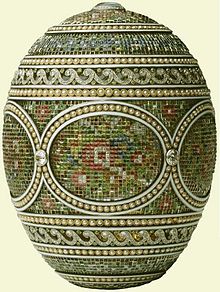- Mosaic (Fabergé egg)
-
Mosaic Fabergé egg 
Year delivered 1914 Customer Alexandra Feodorovna Current owner Individual or institution Elizabeth II Year of acquisition 1933 Design and materials Workmaster Albert Holmström Materials used gold, platinum, enamel, diamond, various gems Height 9.5 cm Width 7 cm diameter Surprise 7.9 x 5.5 x 2.9 cm The Mosaic egg is a jewelled enameled Easter egg[1] made under the supervision of the Russian jeweller Peter Carl Fabergé in 1914.[2] The egg was made for Nicholas II of Russia, who presented it to his wife, the Empress Alexandra Feodorovna on Easter 1914.[2]
Contents
Design
The Egg was crafted by Albert Holmström (1876–1925)[1] under the supervision of Peter Carl Fabergé and is made of yellow gold, platinum, brilliant diamonds, rose-cut diamonds, ruby, emerald, topaz, sapphire, garnet, half-pearls, moonstone, white enamel and opaque pink enamel. It consists of a series of yellow gold belts which are pave-set with diamonds and a variety of gems in a floral pattern, providing a look of petit point tapestry work.[2]
The pattern of the egg contains five oval panels bordered by half-pearls set in enamel, with brilliant diamonds placed at each intersection. The technical precision of the design was complimented by platinum that was cut, rather than welded.[1] At the apex of the egg is a moonstone through which can be seen the year 1914 and Empress Alexandra's initials in Russian characters.[1]
Inspiration
The floral tapestry pattern was designed by AlmaTheresia Pihl, who was inspired by needlework fire screens found in aristocratic sitting rooms of the time.[2] Pihl was the niece of the egg's workmaster Albert Holmström, who came from a family of Finnish jewelers employed by Fabergé.[1]
Surprise
The pedestal surprise is made of gold, pearls, rose-cut diamonds, green garnets, translucent green, opaque white, opalescent pale pink, pale green and pale sepia grisaille enamel. The surprise is a removable miniature frame with relief profiles of Nicholas and Alexandra's five children in a cameo brooch style. The back of the frame is enameled with a sepia basket of flowers. The basket is bordered with the year 1914 and the names of each of the Romanov children (Anastasia Nikolaevna, Alexis Romanov, Olga Nikolaevna, Maria Nikolaevna, Tatiana Romanov).[2] The frame rests on a gold stand in the shape of the royal crown and is held in place within the egg by gold clips.[1]
History
The Mosaic Egg was commissioned by Tsar Nicholas II and presented to his wife, Empress Alexandra Fedorovna for Easter 1914. It was later confiscated, along with much of the family's belongings, by the provisional government in 1917 during the Russian Revolution. In 1933 the egg was sold by the Antikvariat to an unknown buyer for 5,000 roubles, though the Royal Collection online object description suggests that it was likely purchased by Armand Hammer.[1] On 22 May 1933 it was purchased from Cameo Corner, London by King George V for 250 pounds "half cost", likely as a gift for Queen Mary of Teck's birthday.
The Mosaic Egg remains a part of the Royal Collection of Queen Elizabeth and was included in a public display from July to October 2011 in the exhibit Royal Faberge during the summer opening of Buckingham Palace.[1]
Other Fabergé eggs in the Royal Collection include:
- Twelve Panel, 1899, Alexander Kelch to his wife Barbara (Varvara) Kelch-Bazanova.
- Basket of Wild Flowers, 1901, Gift of Nicholas II to Empress Alexandra Feodorovna.
- Colonnade, 1910, Gift of Nicholas II to Empress Alexandra Feodorovna.[1]
See also
References
- ^ a b c d e f g h i "Mosaic Egg". Faberge in the Royal Collection. RoyalCollection.org.uk. http://www.royalcollection.org.uk/eGallery/object.asp?searchText=Faberge+egg&x=0&y=0&pagesize=20&object=9022&row=23&detail=about. Retrieved 2 October 2011.
- ^ a b c d e "1914 Mosaic Egg". Mieks Faberge Eggs. mieks.com. http://www.mieks.com/faberge-en/1914-Mosaic-Egg.htm. Retrieved 2 October 2011.
External links
- Images of the Mosaic Egg, Buckingham Palace Royal Fabergé exhibition (Flickr).
- A detailed article on the Mosaic egg from mieks.com
Categories:- 1914 works
- Fabergé eggs
- Jewellery of the Royal Collection of the United Kingdom
Wikimedia Foundation. 2010.
